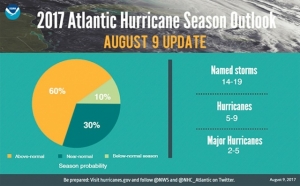Forecasters say 2017 hurricane season has potential to be 'extremely active'
By News-Argus Staff
Published in News on August 10, 2017 9:25 AM
NOAA forecasters on Wednesday said the 2017 hurricane season has the potential to be "extremely active," and could be the most active one since 2010, with 14 to 19 named storms.
The number of predicted named storms and major hurricanes was increased in a Wednesday NOAA statement.
Forecasters now say there is a 60-percent chance of an above-normal season -- compared to the May prediction of a 45-percent chance -- with 14 to 19 named storms (increased from the May predicted range of 11 to 17) and 2 to 5 major hurricanes (increased from the May predicted range of 2 to 4).
A prediction for 5 to 9 hurricanes remains unchanged from the initial May outlook.
The numbers announced Wednesday include the season activity through today.
In the first nine weeks of the season there have been six named storms.
That is half the number of storms during an average six-month season and double the number of storms that would typically form by early August.
An average Atlantic hurricane season, which runs from June 1 to Nov. 30, produces 12 named storms, of which six become hurricanes, including three major hurricanes.
So far this season the Atlantic basin has had six named storms -- Arlene in April; Bret and Cindy in June; Don and Emily in July; and Franklin in August.
Cindy and Emily struck the U.S.
Cindy made landfall on June 22 at the Louisiana-Texas border. Its heavy rainfall caused inland flooding. The storm also generated multiple tornado outbreaks.
Emily made landfall on July 31 at Anna Maria Island, Florida.
Franklin is predicted to make landfall in Mexico overnight Wedneday as a hurricane.
A tropical disturbance is developing 350 miles east off the northern Leeward Islands while a second one is developing over the Bahamas.
Gerry Bell, Ph.D., lead seasonal forecaster at NOAA's Climate Prediction Center, said the wind and air patterns in the area of the tropical Atlantic and Caribbean, where many storms develop, are very conducive to an above-normal season.
Also, other factors pointing to an above-normal season include warmer waters across the tropical Atlantic than models previously predicted and higher predicted activity from available models, Bell said.

